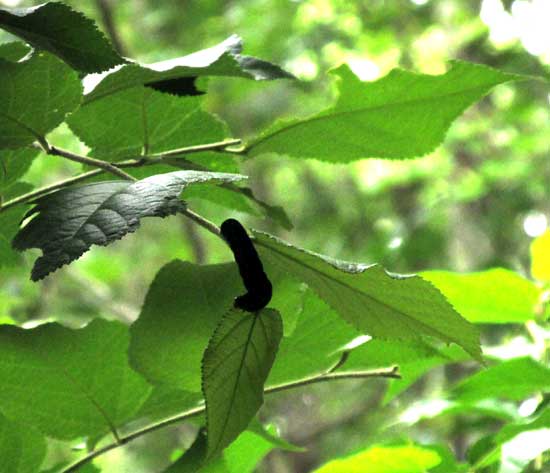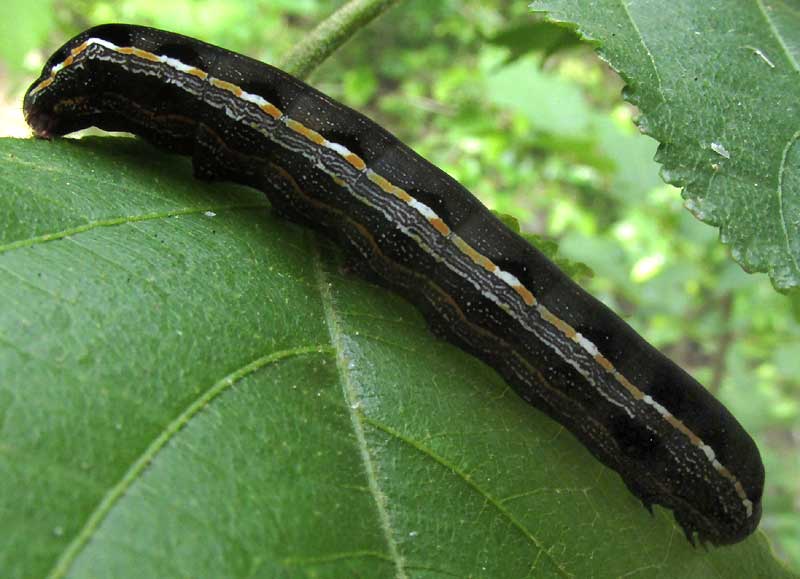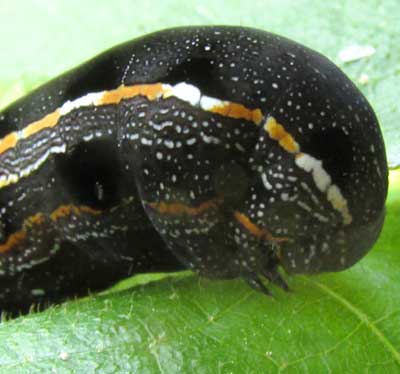Excerpts from Jim Conrad's
Naturalist Newsletter
from the June 25, 2017 Newsletter issued from Rancho Regenesis in the woods ±4kms west of Ek Balam Ruins; elevation ~40m (~130 ft), N20.876°, W88.170°; north-central Yucatán, MÉXICO
YELLOWSTRIPED ARMYWORM
In the Guazuma ulmifolia tree beside the hut's porch, a certain big, black caterpillar for several days had been a conspicuous presence, sometimes feeding but mostly just resting, sometimes atop a leaf, sometimes beneath it, sometimes like he's shown BELOW:

Among the brightly sunlit leaves his black form was so attention-getting that I wondered why the Turquoise-browed Motmots or Altamira Orioles hadn't eaten him. Figuring that volunteer bug identifier Bea in Ontario could figure out who he was I sent her the picture shown below:

Also, the head close-up seen below:

In her usual super-efficient way, before long her verdict came back: Yellowstriped Armyworm, SPODOPTERA ORNITHOGALLI.
Along with the ID came her surprising note that this was by no means a species confined to the tropics, like most queries I send. In fact, Bea had photographed Yellowstriped Armyworms at her own place, in southern Ontario! The University of Florida offers a fine page on the wide-ranging, often very destructive species at http://entnemdept.ufl.edu/creatures/veg/leaf/yellowstriped_armyworm.htm
There we learn that Yellowstriped Armyworms are distributed from southern Canada to South America, and on many Caribbean islands. Also, it's not a persnickety feeder, which I'd already concluded because I'd seen it on many kinds of plants here, and for about a week it was abundantly to be seen crossing all roads I biked down. It appeared on my cabbage, beets, onions, the Tree Cotton, roadside morning glories, on and on.
In fact, with the rainy season's advent, lately my garden has received a one-two punch from hordes of big, general-feeding caterpillars. First came the Cassava Hornworms described in our June 4th Newsletter, and then from Yellowstriped Armyworms, which appeared just as the the hornworms were fading.
Over the days, the big armyworm beside the hut porch became part of the family, and I was hoping to watch him form a pupa. However, one morning he'd disappeared, and I wondered whether the motmot or oriole finally had noticed him. More likely is that sometime during the night the caterpillar descended the tree's trunk and entered the soil, for the University of Florida page mentioned above says that that larvae pupate in the soil within a cell containing a thin lining of silk.
The pupal stage lasts from nine to 22 days,. The adult stage is a brownish gray moth nicely camouflaged for emerging from leaf litter and resting on tree trunks.